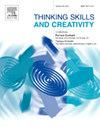培养数学创造力:以中学教师课堂实践为例
IF 3.7
2区 教育学
Q1 Social Sciences
引用次数: 0
摘要
本研究的目的是考察数学教师在课堂上培养数学创造力的行为。本研究采用个案研究设计,并采用有目的的抽样方法选择研究对象。为此目的;对900名中学数学教师进行了创造性培养行为指数调查。计算完成量表的教师的得分,并对10名得分较高的教师进行半结构化访谈。在访谈中,教师被问及数学创造力和培养创造力的策略。从这些访谈中,选择观点与文献最接近的教师作为参与者。为了从这位老师那里收集更详细的数据,我们对她的课堂活动进行了深入的调查。此外,为了分析教师在课堂上的行为,我们观察了她的课程,然后进行了观察后的访谈。现场笔记、学生笔记本和观察录音也包括在数据集中。结果显示,教师对数学创造力有较强的概念知识,并积极寻求在课堂上培养创造力。然而,由于种种原因,她无法将自己的概念知识和观点完全转化为课堂实践。本文章由计算机程序翻译,如有差异,请以英文原文为准。
Fostering mathematical creativity: A case study of middle school teachers' classroom practices
The purpose of this study is to examine the behaviors of mathematics teachers that foster mathematical creativity in the classroom. A case study design was employed, and a purposive sampling method was used to select the participant. For this purpose; The Creativity Fostering Teacher Behavior Index was sent to nine hundred middle school mathematics teachers. The scores of those who completed the scale were calculated, and semi-structured interviews were conducted with ten teachers who scored high on the scale. During the interviews, teachers were asked questions about mathematical creativity and strategies to foster creativity. From these interviews, the teacher whose views most closely aligned with the literature was selected as a participant. To collect more detailed data from this teacher, her classroom activities were examined in depth. Additionally, to analyze the teacher’s behaviors in the classroom, her lessons were observed, followed by post-observation interviews. Field notes, students’ notebooks, and audio recordings from the observations were also included in the data set. The findings revealed that the teacher had strong conceptual knowledge regarding mathematical creativity and actively sought to foster creativity in the classroom. However, it was concluded that, for various reasons, she was unable to fully translate her conceptual knowledge and perspectives into classroom practice.
求助全文
通过发布文献求助,成功后即可免费获取论文全文。
去求助
来源期刊

Thinking Skills and Creativity
EDUCATION & EDUCATIONAL RESEARCH-
CiteScore
6.40
自引率
16.20%
发文量
172
审稿时长
76 days
期刊介绍:
Thinking Skills and Creativity is a new journal providing a peer-reviewed forum for communication and debate for the community of researchers interested in teaching for thinking and creativity. Papers may represent a variety of theoretical perspectives and methodological approaches and may relate to any age level in a diversity of settings: formal and informal, education and work-based.
 求助内容:
求助内容: 应助结果提醒方式:
应助结果提醒方式:


